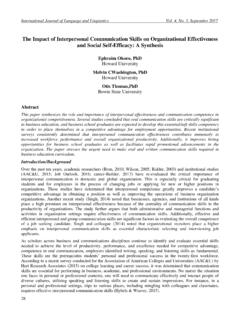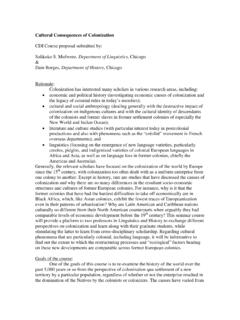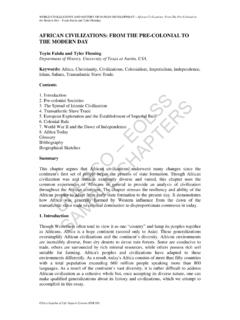Transcription of Linguistics across Cultures: The Impact of Culture on ...
1 1. Linguistics across Cultures: The Impact of Culture on second language learning Ming-Mu Kuo Assistant Professor, the Department of Foreign language Instruction Wenzao Ursuline College of Languages Kaohsiung, Taiwan Cheng-Chieh Lai PhD Program Student in Educational Leadership Prairie View A&M University Texas, USA. Abstract: The purpose of this article is to discuss the inseparable relation between Culture and lan- guage and the implementation of instructional strategies for teaching second language through Culture to enhance students' linguistic comprehension. language is not only the product of Culture , but also is the symbol of Culture (Gleason, 1961). Culture must be in- corporated outright as an essential component of second language learning and teaching. Only after cultural issues become an inherent part of the language curriculum and instruc- tion, can students be successful in their target language learning .
2 second language teachers, therefore, should pay more attentions to the diversities of cultures, identify key cultural items in every aspect when they design a language curriculum, and apply appro- priate teaching strategies to learning activities in order to help students to bridge the cul- ture gaps. 2 Journal of Foreign language Instruction The purpose of this article is to discuss people live, their behaviors and thoughts fol- the inseparability of Culture and language and low and are generally based on their own cul- to propose ways of implementing instructional tures. Culture has many different dimen- strategies for teaching second language sions. It includes ideas, customs, skills, arts through Culture to enhance students' linguistic and tools that characterize a group of people comprehension. People who live in different in a given period of time; it is also the beliefs, areas of the world have different cultural values, and material objects that create our backgrounds and use different languages.
3 Way of life. Culture establishes a context of language and Culture appear on the surface to cognitive and affective behavior for each per- be two distinct fields, but they have an inter- son. It influences individual estimation and twined relationship and affect each other mu- attitudes, and can also have an effect on prac- tually. Gleason (1961) indicated that lan- tical aspects of life such as hobbies. guages are not only the products of cultures, Culture is also a matter of habit, and it is but also are the symbols of cultures. The de- habit that becomes tradition and tradition that velopment of a language frequently affects its gives rise to Culture . Local people begin with associated Culture , and cultural patterns of habitual actions and go on to create common cognition and custom are often explicitly stereotypes. Condon further explained that coded in language . stereotypes assign group characteristics to in- Furthermore, language is also a social in- dividual purely on the basis of their cultural stitution, both shaping and being shaped by membership.
4 The cultural stereotypes affect society (Armour-Thomas & Gopaul-McNicol, how people think, speak, act, and interact with 1998). Ihis means that language is not an in- one another. Samovar, Porter, and Jain (1981). dependent construct but social practice both also stated that Culture and communication are creating and being created by the structures inseparable because Culture not only dictates and forces of social institutions within which who talks to whom, about what, and how the we live and function. Certainly, language communication proceeds, but also helps to cannot exist in a vacuum and there is an in- determine how people encode messages, the evitable kind of transfusion at work between meanings they have for messages, and the language and Culture (Fairclough, 1989). It conditions and circumstances under which follows, then, that learning a new language various messages may or may not be sent, no- will also involve grapping with the notion of ticed, or interpreted.
5 In a word, Culture is the Culture in relation to language . foundation of communication. Without Culture , we can not understand the lives and motivations of others and con- Definition of Culture nect with their concerns and interests. Culture is inherent in our being and a powerful human According to Condon (1973), Culture can tool to develop our society, add to our knowl- be defined as a way of life. No matter where edge, and establish the relationships between Linguistics across Cultures: The Impact of Culture on second language learning 3. people. However, Culture is fragile. The traits tion. In many ways the structure of language of Culture are constantly changing and easily reflects the structure of how our minds process lost. If we do not value it, we will lose it the world. According to Douglas (2000), there eventually. are four different dimensions of language . There are: competence and performance;. comprehension and production; nature and What is Linguistics ?
6 Nurture; and universal grammars. Three ques- tions need be considered before analyzing the Linguistics is the scientific study of lan- structure of a language : guage. It is a foundational discipline in the sense that it bridges the social sciences, the 1. What are the rules or principles that natural sciences, and the humanities (Harris, predict how sounds are made and 1951). Linguistics is an exciting field, not only how are they used (phonol- because of its own achievements, but also be- ogy-patterning of sounds)? cause of its contributions to other fields. In the 2. How do sound sequences convey language domain, the study of Linguistics en- meaning and how are meaningful deavors to answer many questions, one of sound sequences strung together to which is: What is language and how is it rep- form words (morphology-patterning resented in the mind? Linguists focus on de- of sound sequences and words)? scribing and explaining language .
7 It is a disci- 3. How are words strung together to pline concerned with how languages are simi- form phrases and sentences (pattern- lar to and different from one another. In addi- ing of phrases and sentences)? tion, Linguistics is also a social science that shares common ground with other social sci- Understanding a language should first ences such as psychology, anthropology, soci- involve understanding its patterns of sound. ology, and archaeology. For this reason, to All languages have definite patterns in the understand the changing nature of language , sounds that the speaker use, how those sounds we have to look at psychological issues, such are combined to form symbols, and how those as learning ability and perception, and social symbols are organized into meaningful sen- factors. We need to understand the structures tences. Douglas (2000) further indicated that and functions of languages which play a part each language structure consists of four dif- in our social activities in order to be a suc- ferent areas: phonology (the basis of speech cessful use of language .)
8 Sound), semantics (word meanings and or- ganization of concept), grammar (include Structure of language Morphology and Syntax), and pragmatics (the use of language in contexts). In fact, some language is a system of symbols and languages have similar structural patterns rules that is used for meaningful communica- while others are totally different. One of the 4 Journal of Foreign language Instruction reasons why some people have difficulty vironment, to cause certain events to learning another language is often related to happen. language structures. For instance, Chinese and 2. Regulatory function: when language English languages have unique and totally controls events. The regulations may different structures. encounter the approval or disap- However, the structure of a language can proval of the listener. be learned because human beings have a 3. Representational function: when natural and inherent competence to acquire language is used to make statements, languages.
9 According to language acquisition convey facts and knowledge, explain theory, language learners usually need a or report. transformational period when they are learn- 4. Interactive function: when language ing a new language . They must apply and serves to ensure social maintenance, compare the structures of their mother tongue this implies knowledge of slang, jar- to the new language in order to understand its gon, jokes, folklore, cultural mores, patterns. A good example of this is in bilin- politeness, and formality expecta- gual education. The theories of bilingual edu- tions in social exchange. cation believe that when new second language 5. Personal function: when language learners encounter an unfamiliar language in expresses feelings, emotions, and the first time, they are often confused and dis- personality. oriented. But, after becoming familiar with the 6. Heuristic function: when language is structure of the language , they eventually dis- used to acquire knowledge and to learn.
10 Cover its rules and how the various parts are 7. Imaginative function: when language interrelated (Krashen, 1994). is used to create tales, write a novel, poetry, tongue twisters, and etc. Functions of language All functions of language lead back to the language is a system of signals, includ- three elements that are indispensable to the ing voice sounds, gestures or written symbols formation of a proposition: the subject, the which encodes and decodes information. The predicate, and the link between them. Each goal of language is to communicate meaning. function has its objective to help us to deal When we begin to develop our language abili- with the necessities of daily life. ties, the main purpose is to communicate or interact with others. Halliday (1973, p. 10). suggests that the functions of language can be The Relationship between Lin- separated in seven areas, included: guistics and Culture 1. Instrumental function: when lan- language and Culture are intertwined, guage is used to manipulate the en- and one will affect the other.
















